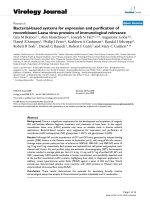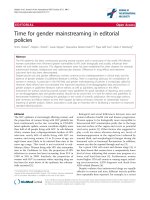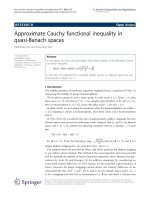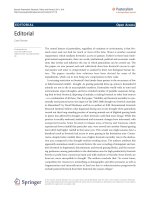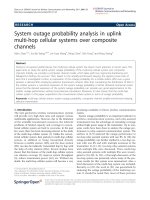Báo cáo hóa học: " Editorial Embedded Systems Design in Intelligent Industrial Automation" pdf
Bạn đang xem bản rút gọn của tài liệu. Xem và tải ngay bản đầy đủ của tài liệu tại đây (425.1 KB, 2 trang )
Hindawi Publishing Corporation
EURASIP Journal on Embedded Systems
Volume 2008, Article ID 194697, 2 pages
doi:10.1155/2008/194697
Editorial
Embedded Systems Design in Intelligent
Industrial Automation
Luca Ferrarini,
1
Jose L. Martinez Lastra,
2
Allan Martel,
3
Antonio Valentini,
4
and Valeriy Vyatkin
5
1
Dipartimento di Elettronica e Informazione, Politecnico di Milano, Milano 20133, Italy
2
Department of Production Engineering, Tampere University of Technology, 33101 Tampere, Finland
3
O
3
neida Inc., 135 Dunbarton Court, Ottawa, Ontario, Canada K1K 4L6
4
O
3
neida Europe, 42 rue de l’Eglise, 1150 Brussels, Belgium
5
Department of Electrical and Computer Engineering, University of Auckland, Private Bag 92019,
Auckland 1142, New Zealand
Correspondence should be addressed to Valeriy Vyatkin,
Received 16 January 2008; Accepted 16 January 2008
Copyright © 2008 Luca Ferrarini et al. This is an open access article distributed under the Creative Commons Attribution License,
which permits unrestricted use, distribution, and reproduction in any medium, provided t he original work is properly cited.
Industrial automation (IA) is the vast area of embedded
computing devoted to industrial applications. Apart from
many tailored solutions (numerical controllers, hardware
controllers, etc.) the scene is dominated by programmable
logic controllers, widely known by the abbreviation PLC,
which represent the most wide-spread class of embedded
computing platforms. In the past, the progress in embedded
technologies has determined qualitative breakthroughs in the
performance of automation systems, their affordability and
efficiency of their design.
Intelligent industrial automation (IIA) has appeared as
a branch of research and development, answering the chal-
lenges of flexible and adaptive manufacturing, which require
mass customization instead of mass production. It stipu-
lates the use of information and communication technol-
ogy (ICT) methods and tools for creating self-configurable
or easily-reconfigurable control systems to automate manu-
facturing processes.
The automation systems need to go beyond being a col-
lection of networking PLCs—they should be intelligent in the
way that they interact and behave and how they are used by a
range of people, from control engineers to maintenance tech-
nicians. That is why the newly emerging trends in automa-
tion deal with service-oriented architectures, knowledge en-
gineering, and Web-services. Most solutions to safety and
predictive maintenance issues are implemented nowadays by
such novel embedded solutions as wireless smart sensor net-
works.
Automation systems research faces the same significant
challenges as does the embedded systems world, of which it
is an integral part. One of these is the quest for integrated
high-level design methods, languages, and tools [1]. In the
automation domain this has translated into the development
of component-based software architectures supporting vi-
sual programming, such as the IEC 61499 standard [2]and
strategies for controlling distributed applications [3].
The challenges of designing these applications using em-
bedded technologies are also contributing to the develop-
ment of the embedded technologies themselves, in turn giv-
ing rise to new challenges.
This special issue is organized in collaboration with
O
3
neida [4], the global organization, operating as a network
of networks to promote distributed industrial automation
based upon open standards.
Taking the O
3
neida perspective of the IA value added
chain [5] means that an IA solution, developed or deployed
by any organization, must include an analysis of the impli-
cations on the company’s internal processes, on the manage-
ment of its extended supply chain, all within the context of
the complete product life c ycle.
O
3
neida has recently extended its interest into new
research-intensive application areas of IIA, such as
(i) energy management,
(ii) building automation,
(iii) health over Internet protocol (HoIP).
O
3
neida facilitates collaboration of industrial, academic,
and research organizations by providing collaborative frame-
works within which to conduct national and international
research and development projects.
2 EURASIP Journal on Embedded Systems
It also helps with knowledge transfer by supporting new
publication initiatives, such as this special issue, or a series
of industrial automation books, recently launched with the
Instrumentation Society of America.
O
3
neida also works to develop and promulgate the inter-
national standards required to promote interoperable intelli-
gent solutions in automation. For example, the joint paper
[3] demonstrates collaboration of O
3
neida members from
9 organizations worldwide, in the work, aiming at the im-
provement of the IEC 61499 standard.
Finally, O
3
neida has recently opened O
3
neida Europe, its
second international node focused on European industrial
automation activities. O
3
neida Asia is expected to be formed
later this year.
This sp ecial issue is a fine example of the collaboration
environment, created by O
3
neida and enthusiastically sup-
ported by its members.
The papers, selec ted for this special issue, cover a wide
spectr um of the automation research, concerning topics such
as extending the capabilities of embedded computing plat-
forms, or using them to the benefit of automating demand-
ing manufacturing systems. These papers can be divided
onto three thematic groups.
The first group refers to the high-level system engineer-
ing in flexible and reconfigurable manufacturing, imple-
menting the idea of system-level languages in the IIA do-
main, which naturally leads to the new generation of em-
bedded control devices beyond PLCs. In particular, the pa-
per by Ferscha et al. proposes a higher-level design method-
ology for flexible manufacturing systems with dist ributed
control. The work by Ferrarini et al. applies metamodel-
ing and model-driven architectures techniques for reconfig-
urable control of manufacturing systems. New programming
architectures and methodologies for such controllers, in par-
ticular the novel IEC 61499 architecture, are discussed by
Gerber et al. and Dubinin et al. Thus, Gerber et al. investi-
gate migration from the currently dominating PLC architec-
ture of IEC 61131-3 to IEC 61499. Dubinin et al. propose a
formal syntactic model of IEC 61499, needed to address the
issue of its execution semantics.
The second group of papers addresses the solutions en-
abling intelligent networking, which progresses from sim-
ple device connectivity to provision of web-services and the
use of service-oriented architectures. The latter imposes new
requirements to the resource-constrained embedded plat-
forms. Maci
´
a-P
´
erez et al. deal with the problem of managing
control applications and embedded services in automated
equipments through a specialized reference frame of IT ser-
vices. Collado et al. address the problem of implementing
an XML parser on embedded device. The growing popular-
ity of XML makes this work very relevant to many automa-
tion applications. Thramboulidis et al. propose the use of
service-oriented architectures (SOA) as an integration tech-
nology to “glue” different applications, used in the design of
intelligent automation systems. L
´
opez Orozco et al. deal with
performance of the FIPA agent-based protocols, which pro-
vide a higher-level communication language for intelligent
automation nodes.
The third group of papers represents the important area
of verification and validation of embedded automation sys-
tems. Vyatkin et al. propose a visual specification language
to be used in formal verification of modular automation sys-
tems.
The works included in this special issue certainly cannot
represent the whole body of relevant research. They rather
highlight some exciting application areas of advanced em-
bedded technologies. We hope this special issue will facilitate
joint research between the industrial automation and the em-
bedded systems research communities.
Luca Ferrarini
Jose L. Martinez Lastra
Allan Martel
Antonio Valentini
Valeriy Vyatkin
REFERENCES
[1] T. A. Henzinger and J. Sifakis, “The discipline of embedded sys-
tems design,” Computer, vol. 40, no. 10, pp. 32–40, 2007.
[2] “Function blocks for industrial-process measurement and con-
trol systems—part 1: architecture,” International Electrotechni-
cal Commission, Geneva, Switzerland, 2005.
[3] C. S
¨
under, A. Zoitl, J. H. Christensen, et al., “Usability and in-
teroperability of IEC 61499 based distributed automation sys-
tems,” in Proceedings of the 4th IEEE Conference on Industrial
Informatics (INDIN ’06), pp. 31–37, Singapore, August 2006.
[4] OOONEIDA, .
[5]V.V.Vyatkin,J.H.Christensen,andJ.L.M.Lastra,
“OOONEIDA: an open, object-oriented knowledge economy
for intelligent industrial automation,” IEEE Transactions on In-
dustrial Informatics, vol. 1, no. 1, pp. 4–17, 2005.


